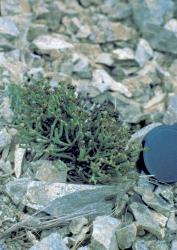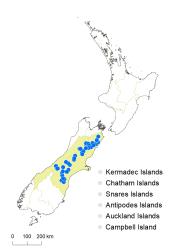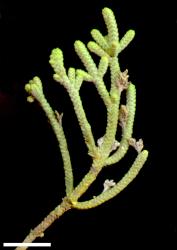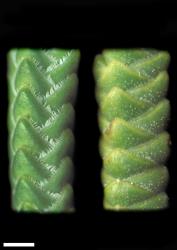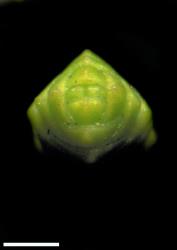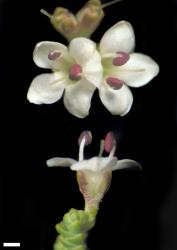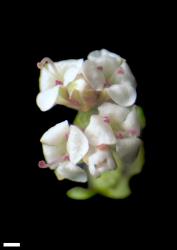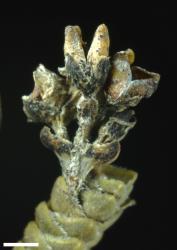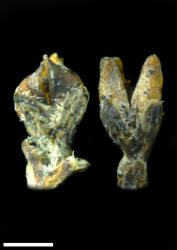- ≡ Mitrasacme cheesemanii Buchanan, Trans. & Proc. New Zealand Inst. 14: 348 (1882)
- ≡ Hebe cheesemanii (Buchanan) Cockayne & Allan, Trans. New Zealand Inst. 57: 39 (1926)
- ≡ Leonohebe cheesemanii (Buchanan) Heads, Bot. Soc. Otago Newsl. 5: 5 (1987)
Semi-whipcord shrub, to 0.3 m tall. Stems decumbent or ascending, glabrous. Leaf bud indistinct, its outer leaves fully grown, diverging. Leaves opposite-decussate, connate in pairs and encircling stem, erecto-patent, densely crowded and overlapping, separating early; lamina sub-coriaceous, deltoid to broadly deltoid, 0.8–1.7 mm long, 1.5–3.0 mm wide, dull pale to dark green above and beneath; veins not evident; surfaces glabrous; margins ciliate except at apex, entire; apex obtuse to acute; bases broad; petiole absent. Inflorescence a lateral spike or raceme, 3.0–7.5 mm long; flowers crowded, 2–6, female or male on separate plants, ♂ > ♀; bracts opposite-decussate or the upper sometimes alternate, free or barely connate, deltoid, the lower often keeled, > pedicels; pedicels erecto-patent, 0–0.5 mm long, eglandular-hairy all around. Calyx lobes 4, obtuse, equal, 1.5–2.0 mm long, mixed glandular- and eglandular-ciliate. Corolla 3.0–4.5 mm (♀) or 4.0–5.5 mm (♂) diameter; tube white, 1–2 mm long, < calyx, glabrous; lobes 4, white or occasionally flushed pink, erecto-patent to recurved, sub-equal, elliptical to ovate to rhomboid, 2.0–2.5 mm long, obtuse; nectar guides absent. Stamen filaments white, 2 mm long; anthers magenta. Style glabrous, 1–2 mm long. Capsule angustiseptate, obtuse, glabrous, 1.6–2.5 mm long, 1.3–2.5 mm at widest point. Seeds ellipsoid, weakly flattened, smooth, brown, 1.0–1.2 mm long.
V. quadrifaria belongs to a well-supported clade of four species, the semi-whipcord hebes; the other species are V. hookeri, V. tetrasticha, and V. tumida. Relationships within this grouping are unclear.
Semi-whipcord hebes are characterised by and distinguished from true whipcord hebes by very crowded, dull green, scale-like leaves that are long-persistent on old stems, dioecious sexual systems, and angustiseptate capsules.
The most distinctive feature for recognition of V. quadrifaria plants is the four very flat faces of the leafy stem.
V. hookeri plants have longer leaves that taper to an elongated apex; the leafy stem is cruciform in section.
In plants of V. tetrasticha, at least in herbarium (dried) specimens, the leaf margins are inrolled in the middle portion to make the leafy stem appear grooved between the four ridges.
In V. tumida plants the backs of the leaves are swollen and rounded to give a knobby appearance to the ridges of the leafy stem.
Some collections are difficult to distinguish from V. tumida (e.g. from Black Birch Range and Mt Harkness, Awatere Valley) and V. tetrasticha (e.g., some locations near Hanmer Springs).
South Island: Marlborough from Black Birch Range southwards; Westland (a few localities near the Main Divide), Canterbury (mostly in the western mountains to the Kirkliston Range).
The locality for the lectotype of Mitrasacme cheesemanii, Mt Alta, Otago, is not mapped here because it has not been supported by recent collections and is outside the otherwise known range, following Bayly & Kellow (2006). Moore (in Allan 1961) noted, “Not recently recorded as far south as the type locality.”
Alpine rock outcrops and scree. Recorded elevations range from 765 to 1900 m.
Flowers: December–January; fruits: December–February.
2n = 42 (see Bayly & Kellow 2006, as Leonohebe cheesemanii).
Veronica quadrifaria is classified in V. subg. Pseudoveronica sect. Hebe and informally in the “semi-whipcord hebe” group (Albach & Meudt 2010). The semiwhipcord hebe clade is well supported in all molecular studies. V. quadrifaria was placed as sister to V. tetrasticha based on ITS sequence data and sister to V. cupressoides based on cpDNA sequence data (Albach & Meudt 2010).



